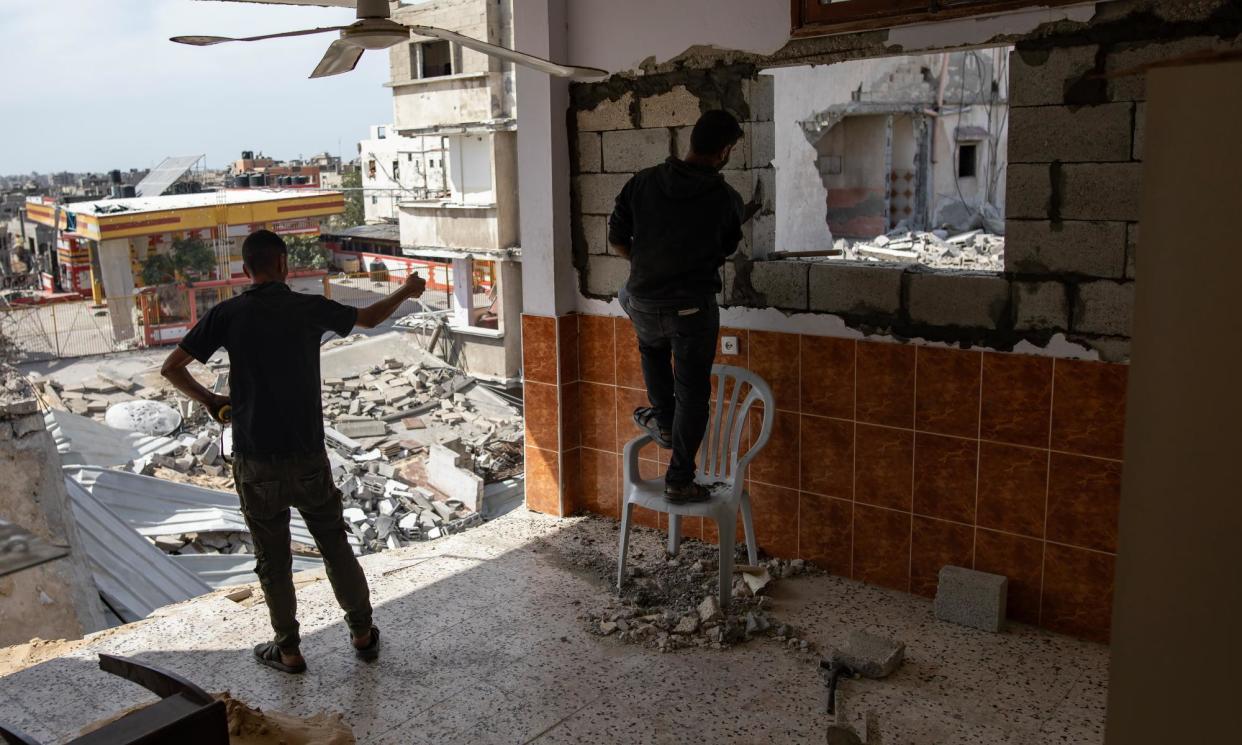Rebuilding homes in Gaza will cost $40bn and take 16 years, UN finds

Rebuilding homes in Gaza destroyed during Israel’s seven-month military offensive could take until 2040 in the most optimistic scenario, with total reconstruction across the territory costing as much as $40bn (£32bn), according to United Nations experts.
An assessment, which is to be published by the UN Development Programme as part of a push to raise funds for early planning for the rehabilitation of Gaza, has also found that the conflict may reduce levels of health, education and wealth in the territory to those of 1980, wiping out 44 years of development.
Expectations of a breakthrough in ceasefire talks in Cairo between Israel and Hamas have cooled in recent days, and many observers believe the conflict is likely to continue, if at varying degrees of intensity, for many months or even longer.
More than 34,500, mostly women and children have died since Israel launched its offensive, according to health authorities in Gaza, after Hamas attacked Israel in October and killed about 1,200 people. The militant Islamist organisation, which took power in Gaza in 2007, also seized 250 hostages.
More than 79,000 homes in Gaza have been “completely destroyed” in the conflict, with another 370,000 damaged, the new assessment found.
“Even under optimistic scenarios for the pace of physical reconstruction, the scale of destruction in Gaza has been such that, simply from the narrow perspective of moving in building materials, it would still take until 2040 and probably longer to restore the housing units destroyed since the start of the war,” the researchers concluded.
In addition, schools, health facilities, roads, sewers, water pipes and all other critical infrastructure have all suffered massive damage.
Abdallah al-Dardari, the director of the UN Development Programme Regional Bureau for Arab States, appealed on Thursday for $100m to start planning to rebuild Gaza despite ongoing hostilities and the absence of any clear plan for administrating the territory from “the day after” the war.
“Imagine if there’s a ceasefire tomorrow and we will need six more months at least to have a plan and start implementing. Those six months will be very dangerous,” al-Dardari told the Guardian.
“You have 2 million people stranded without services. It’s unfair, it’s inhumane if we just abandon the people and wait, say, well, we cannot plan and we cannot invest money until there is a ceasefire.”
Al-Dardari said member states had been “very supportive” of the early planning proposal so far.
The latest round of talks between Israel and Hamas is widely viewed as the last opportunity to salvage a diplomatic solution to pause or end the war and free the hostages held in Gaza.
The proposal that US and Egyptian mediators have put to Hamas – apparently with Israel’s consent – sets out a three-stage process that will bring an immediate six-week ceasefire and partial hostage release but also negotiations over a “permanent calm” that includes some sort of Israeli withdrawal from Gaza, according to an Egyptian official.
During a short-lived pause in hostilities in November, 100 hostages were freed in exchange for about 240 Palestinian women and children held in Israeli jails. Israel estimates that 129 hostages are still held by Hamas, of whom 34 are believed to be dead.
Analysts say Hamas is divided over the question of a new ceasefire deal.
Israel’s war cabinet, which is also split, is due to meet on Thursday evening to discuss the negotiations.
Earlier this week, Benjamin Netanyau, the Israeli prime minister, restated his commitment to launch an Israeli military offensive into the southern city of Rafah, which Israeli officials say is the last remaining stronghold of Hamas. Israel’s bombardment of targets in Gaza has continued in recent days.
More than a million displaced civilians have sought shelter in Rafah and the US president, Joe Biden, has repeatedly told Netanyahu that he opposes any such operation without a convincing plan to protect them. Anthony Blinken, the US secretary of state, emphasised the same message during a meeting with Netanyahu in Tel Aviv on Wednesday.
Blinken also spoke to Netanyahu about the need to sustain humanitarian deliveries to Gaza; the ceasefire negotiations; and efforts to “ensure a lasting, sustainable peace in the region”, a reference to broader talks the US has been holding with Saudi Arabia about a possible normalisation of relations with Israel, as well as the prospects for establishing a Palestinian state, which the Israeli prime minister adamantly opposes.
Al-Dardari said the cost and time needed for the rehabilitation of Gaza, which is in an acute humanitarian crisis, would rise exponentially with every day the war continues.
The possible price tag of reconstruction of Gaza is now twice estimates made by UN and Palestinian officials in January.
“The scale of the destruction is huge and unprecedented. This is a mission that the global community has not dealt with since the second world war,” al-Dardari said.
The latest assessment found that, with the high number of casualties and the big destruction of health facilities in Gaza, life expectancy had already been reduced by a minimum of four or five years and was likely to be reduced by seven, if the war continued into its ninth month. Researchers also found that real GDP per capita in the territory could be reduced to its lowest level since the mid-1990s.
More than 37m tonnes of debris needs to be cleared in Gaza to permit reconstruction. The mountains of rubble are full of unexploded ordnance that leads to “more than 10 explosions every week”, with more deaths and loss of limbs, Gaza’s Civil Defence agency said on Thursday.


